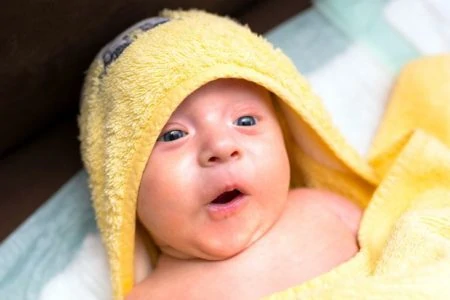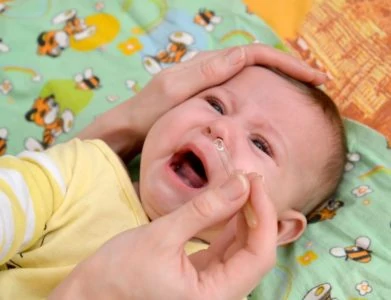When your baby is sick, whether it’s a tummy ailment or cold, possible dehydration is lurking right around the corner. But what do you do when your baby is too little to replenish with water?
Several remedies are available to help your little one battle dehydration. Are you wondering, “Can I give my baby Pedialyte?” We have your answers.
Keep in mind that with babies under 1 year, always proceed with caution, and before administering anything, consult your pediatrician.
Key Takeaways
- Pedialyte helps combat dehydration in babies due to vomiting or diarrhea, by replenishing electrolytes and fluids.
- Consult your pediatrician before giving Pedialyte to babies under 1 year, and follow their guidance on dosage and usage.
- Symptoms of dehydration in babies include fewer wet diapers, tearless cries, and a sunken fontanel (soft spot on the head).
- Never mix Pedialyte with formula or other drinks, as it can disrupt the balance of sugars and electrolytes, potentially worsening symptoms.
What Is Pedialyte?
Pedialyte is a rehydrating product designed to combat dehydration during sickness, travel, heat, or strenuous exercise. It contains a formulated balance of electrolytes and sugar, which work to rebuild the body’s balance. It’s especially useful for babies following, or during, a bout of vomiting or diarrhea.
Pedialyte comes in various forms and flavors (1). These are:
- Pedialyte Classic: This is a liquid form, available in several flavors, or flavorless. It works to restore lost zinc and electrolytes. It’s also available as a powder.
- Pedialyte AdvancedCare: AdvancedCare works to prevent dehydration during sickness. It consists of PreActiv Prebiotics, which help to promote a healthy balance in the digestive system. It’s available in liquid and powder form.
- Pedialyte AdvancedCare Plus: The Plus series contains the same PreActiv Prebiotics as the AdvancedCare but with 33 percent more electrolytes. This makes it more efficient than the two above.
- Pedialyte Sparkling Rush Powder: This powder contains no coloring, only flavors. It features an optimal balance of sugar and electrolytes to combat dehydration effectively.
- Pedialyte Freezer Pops: These are packages of Pedialyte, which you freeze and eat like a popsicle. However, they’re not recommended for infants.
When Is It Safe to Use?
Answers differ about the exact age you can start using Pedialyte. However, some doctors recommend giving it to babies as young as 3 months.
You should always consult your pediatrician before giving a baby under 1 year Pedialyte.
Although Pedialyte is safe in moderation, you shouldn’t take the dosage lightly. Even if your baby likes the taste, it’s not to be used as a treat.
In clinical practice, I only recommend the use of Pedialyte or other oral rehydration fluid during illnesses where there is an excessive fluid loss. In most cases, this occurs with gastroenteritis: vomiting with or without diarrhea.During such an illness, electrolytes and fluid are lost, so it is important that both are replaced. During profuse vomiting, infants often have difficulty tolerating breastmilk and formula. Oral rehydration solutions are a great way to provide fluids that are less irritating during this phase of the illness. The AAP has the following detailed information on electrolyte solutions here.
Editor's Note:
Dr. Leah Alexander, MD, FAAPWhy Give a Baby Pedialyte?
Viruses are often the cause of diarrhea or vomiting in small babies — it’s rarely something they ate. In some cases, it could be a sign of something more serious.
Take Note
During sickness, a lot of fluid can be lost. It’s not uncommon for infants to refuse breastfeeding or formula. Like older children and adults, they experience nausea, gassiness, and cramping which can discourage them from feeding.
Your little one can swiftly become dehydrated. It’s essential to rehydrate them as quickly as possible to avoid complications. Pedialyte can effectively help.
The fluid, electrolytes, and sugar in Pedialyte work as a remedy to dehydration during sickness. This fluid may be easier for your infant to digest particularly during the vomiting phase of the illness.
When your little one is afflicted with diarrhea or vomiting, however, don’t jump to the conclusion that Pedialyte will resolve it. Although Pedialyte can help replenish the body, it’s not a cure or medicine.
Warning
Dehydration In Babies
Dehydration is when the body has lost a significant amount of fluids. Along with liquids, the sufferer loses essential minerals, which can quickly turn serious, especially for young babies.
Symptoms of dehydration in babies aren’t always easy to spot — it depends on their age and how severe it is (2).
Early to moderate signs of dehydration include:
- Less playfulness (not easy to spot in infants — they may seem withdrawn, and not as interested as usual).
- Fewer, or no tears when crying.
- Fewer wet diapers (for infants, look for less than six per day).
- Watery, foul-smelling stool (due to diarrhea). I explain that diarrheal stools are watery like “turning on a faucet.” This helps parents distinguish normal liquid stools from breastfeeding and formula from diarrhea.
- Fewer bowel movements (due to lack of fluids from vomiting or fever).
- Sunken fontanel, which is the soft spot on your baby’s head.
- Dry mouth.
Severe signs of dehydration include:
- Drowsiness.
- Sunken eyes.
- Cool hands or feet that appear discolored.
- Fussiness.
- Only one or two wet diapers in a day.
- Wrinkled skin.
Giving Pedialyte to Breastfed Infants
When rehydrating a breastfed baby using Pedialyte, you should continue to nurse throughout the treatment. Nursing will help comfort your little one, as well as providing them with much-needed nutrition (3).
Breast milk contains essential antibodies, which can help combat sickness. It will also aid the rehydration treatment, perhaps even speeding up the process. However, it is possible for your infant to have a temporary lactose intolerance during these illnesses. Exposure to lactose can prolong the symptoms of gastroenteritis. Avoiding maternal consumption of dairy while breastfeeding allows your infant to receive all of the benefits of breast milk without the digestive issues. Once the illness has resolved, he or she should tolerate dairy in your diet again (4).
Nurse your little one in shorter intervals than usual during the rehydration process. This prevents vomiting from the stomach getting “too full” while irritated from the infection. Then stick to a schedule of every two hours, or as your baby needs. Once they get their tolerance and appetite back, you can increase the time between the sessions.
Between each session, offer 0.15 to 0.3 fluid ounces (5 to 10 milliliters) of Pedialyte using a teaspoon or syringe every five minutes (5).
If your baby is vomiting, wait until they’ve stopped for approximately eight hours until you resume their normal feeding schedule. Continuing to nurse as usual may cause additional distress to their stomach and intestines. Even when they are still having vomiting incidents, continue to offer the Pedialyte every five minutes.
I recommend that parents wait 30 minutes to an hour after a vomiting episode before offering large amounts of fluid. This gives the stomach a chance to “settle” and reduces the likelihood of vomiting immediately after trying to drink fluids.
Editor's Note:
Dr. Leah Alexander, MD, FAAPGiving Pedialyte to Formula-Fed Infants
For formula-fed babies, it’s best to halt the formula until they can keep fluids down. As with breastfed babies, offer Pedialyte, in small quantities of 0.15 to 0.3 fluid ounces, using a teaspoon or syringe every five minutes. Once your baby can keep liquids down, continue with the formula.
If your infant takes a cow’s milk-based formula, it is often helpful to switch to soy formula during the diarrheal phase of the illness. This avoids lactose, which is more difficult to digest and can prolong the illness and helps to bind the stools a bit.
If you’re worried that your little one may begin to vomit again, offer the formula on a spoon. This ensures they consume only small amounts, which can help prevent their tummy from rejecting it.
Take Note
Giving 1-Year-Olds Pedialyte
If you’re breastfeeding or giving formula, follow the guidelines as above. Then as needed, give your child small sips of Pedialyte every 15 minutes. If necessary, use a syringe or spoon.
Consult your doctor if you feel that more Pedialyte is necessary, or if your baby still seems dehydrated.
Side-Effects to Pedialyte
Pedialyte isn’t without its side-effects. But fortunately, most who take Pedialyte don’t experience severe reactions.
The most common side effect is vomiting and nausea. You can counter this by giving your baby small amounts at a time — never more than two teaspoons (6).
Here are a few of the more severe side effects Pedialyte can cause:
- Dizziness (not easy to spot in infants).
- Swelling in feet and ankles.
- Mood changes (they may be difficult to soothe one minute, and a breeze the next).
- Restlessness.
- Seizures.
Although allergic reactions to Pedialyte are rare, here are the signs you should look for:
- Itching or swelling (tongue, face, or throat).
- Rashes.
- Difficulty breathing.
- Severe dizziness.
What To Do About Side Effects
Mixing Pedialyte with Other Drinks
For children over one, if they don’t like the taste of Pedialyte, you may feel tempted to mix with soda or juice. We don’t recommend doing this.
I see this Pedialyte “taste aversion” in toddlers very often. In such cases, I recommend that parents give electrolyte-enhanced water or coconut water. Both have electrolytes, are low in sugar, and have little to no flavor. I do not recommend this under the age of 1, however.
Editor's Note:
Dr. Leah Alexander, MD, FAAPPedialyte consists of a finely tuned formula — it has just the right amount of sugars and electrolytes. By adding a sugary drink like soda or juice (even diet), you’ll meddle with the balance. It could interfere with the effectiveness or make symptoms worse.
By adding more sugar, your baby’s gut may begin to put out additional water and electrolytes, loosening the bowel movements (7). This, in turn, could make diarrhea more serious.
Stay Hydrated
Seeing your baby sick is one of the downsides to parenthood, especially when they’re experiencing vomiting, fever, and diarrhea. When losing fluids, babies quickly become dehydrated, which can have serious outcomes if not treated. It’s essential to know the early warning signs such as fewer wet diapers, tearless cries, and sunken soft spots.
Pedialyte is an excellent way to combat dehydration, even in babies under 1 year. It is, however, vital that you consult your pediatrician beforehand. We recommend asking about possible side effects, dosage, and how to continue nursing.
The AAP has some additional advice on how to manage these illnesses here.
So, the answer to the question “Can I give my baby Pedialyte?” is yes, you can, but proceed with caution.






